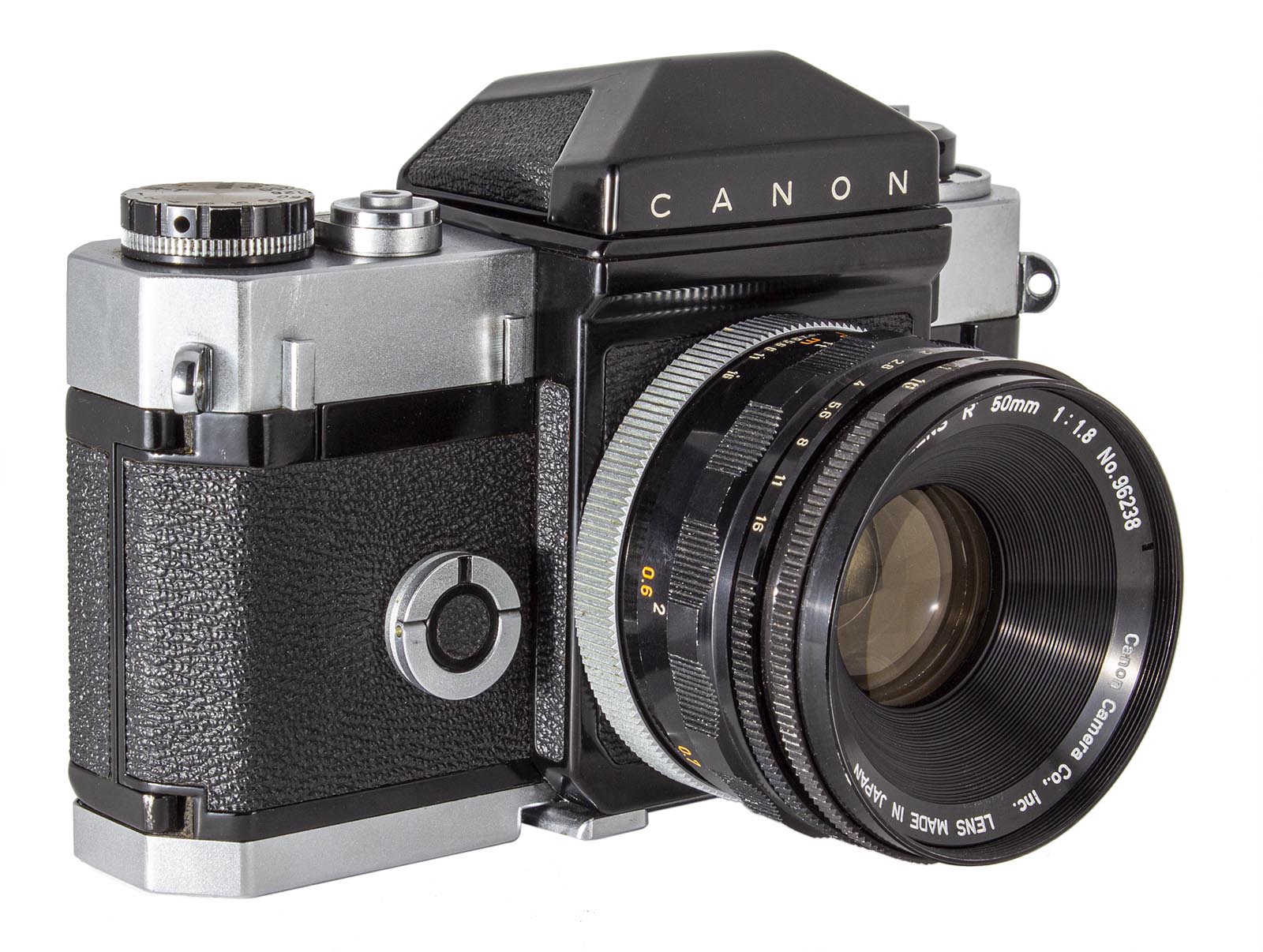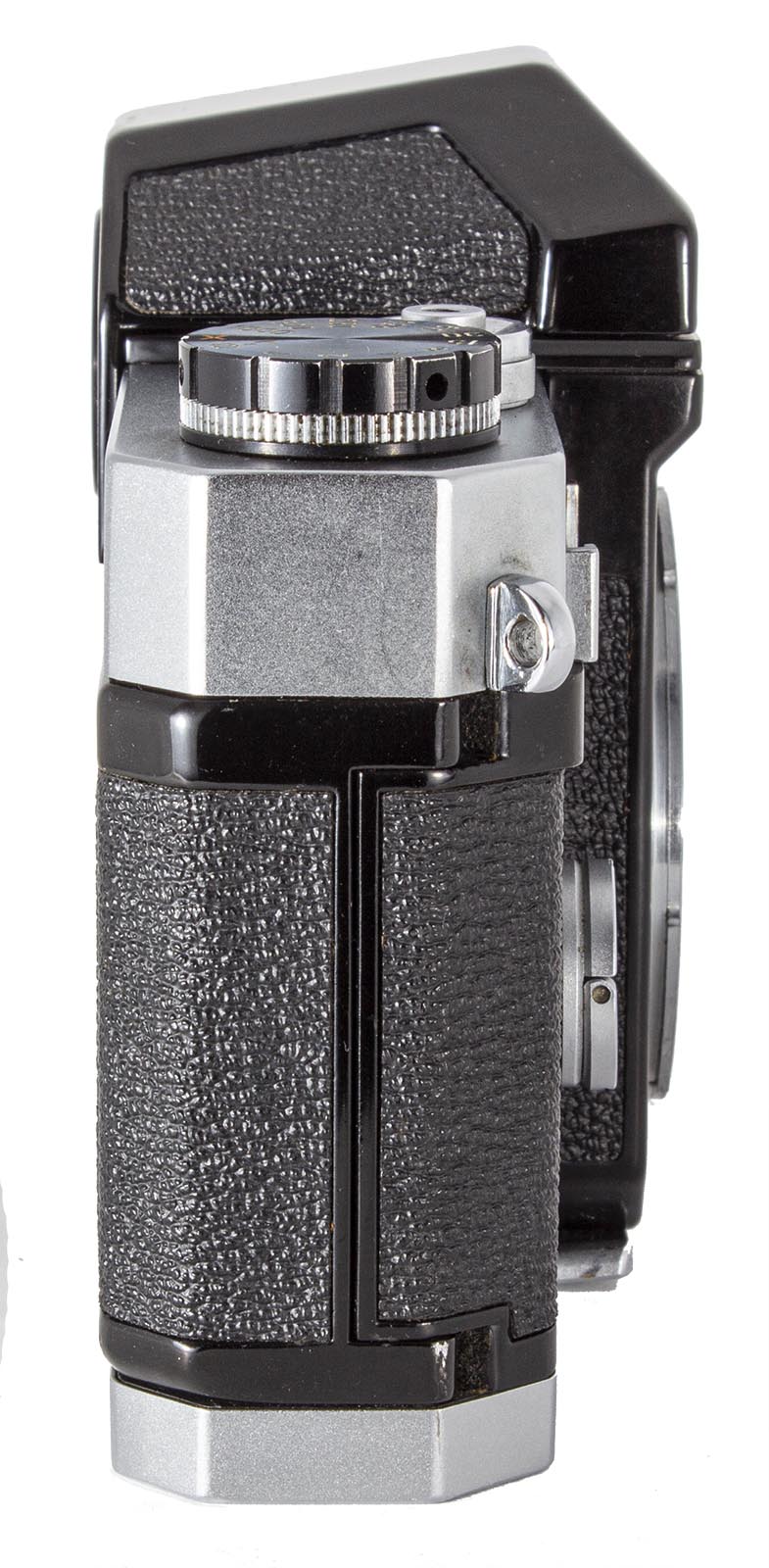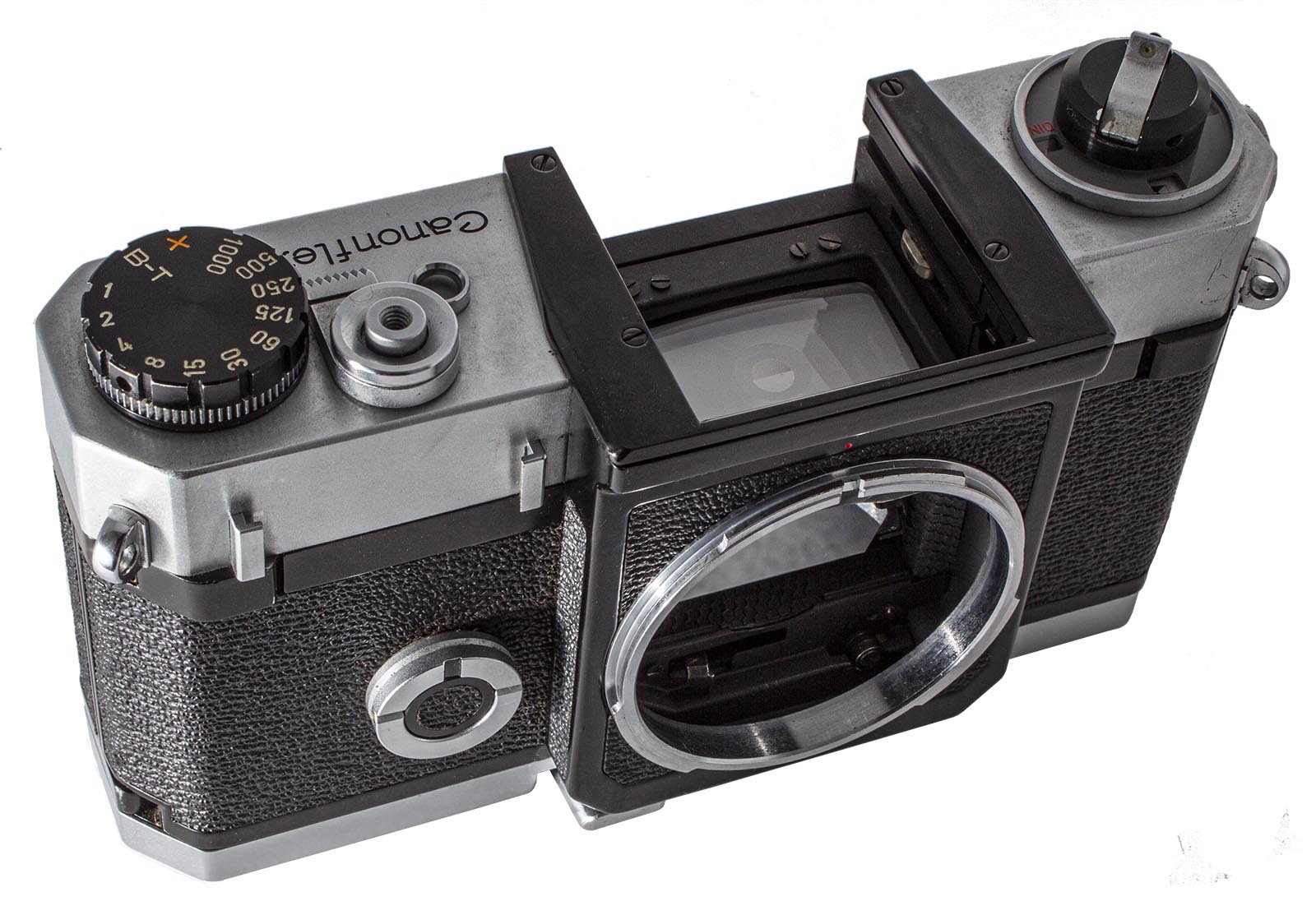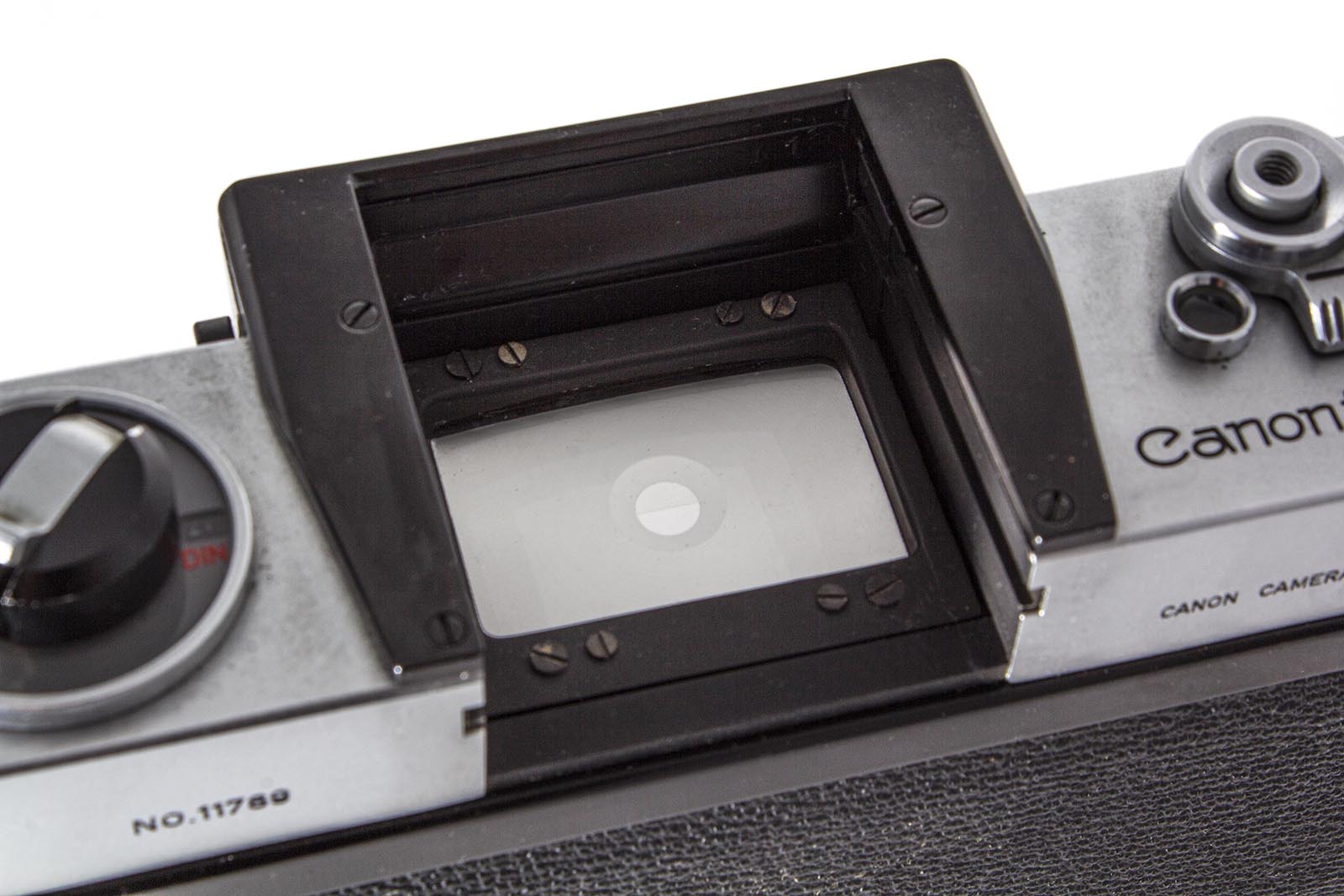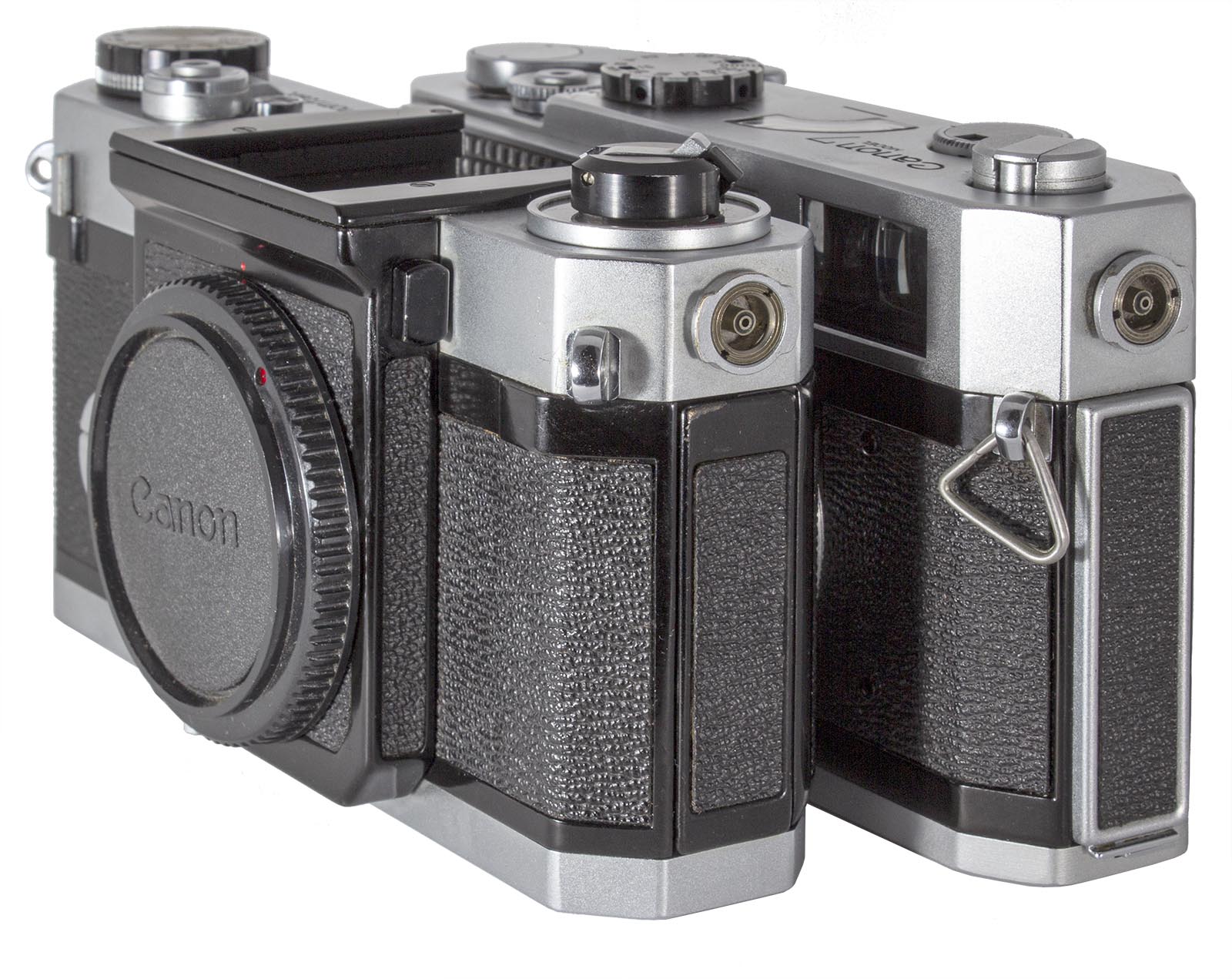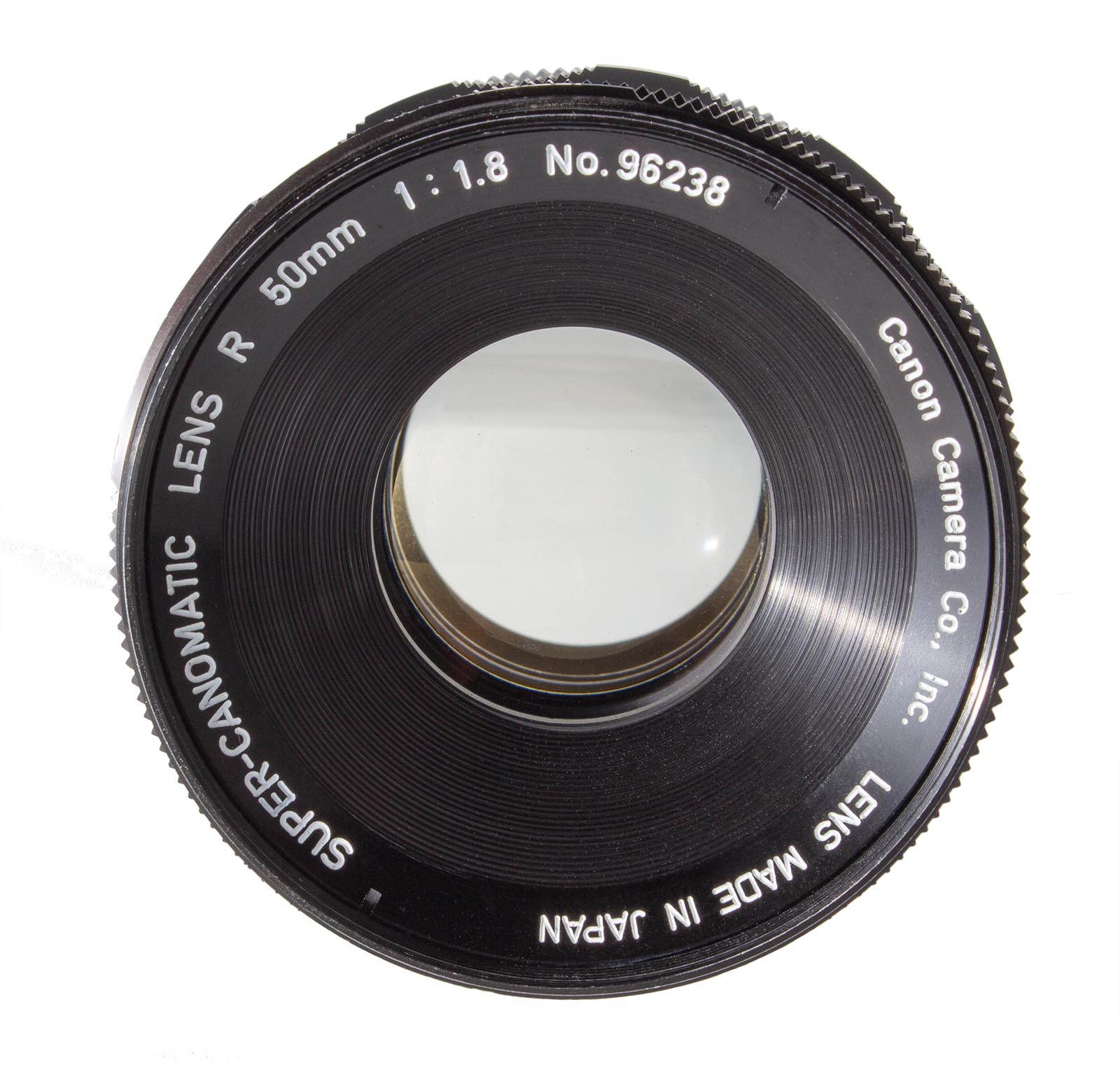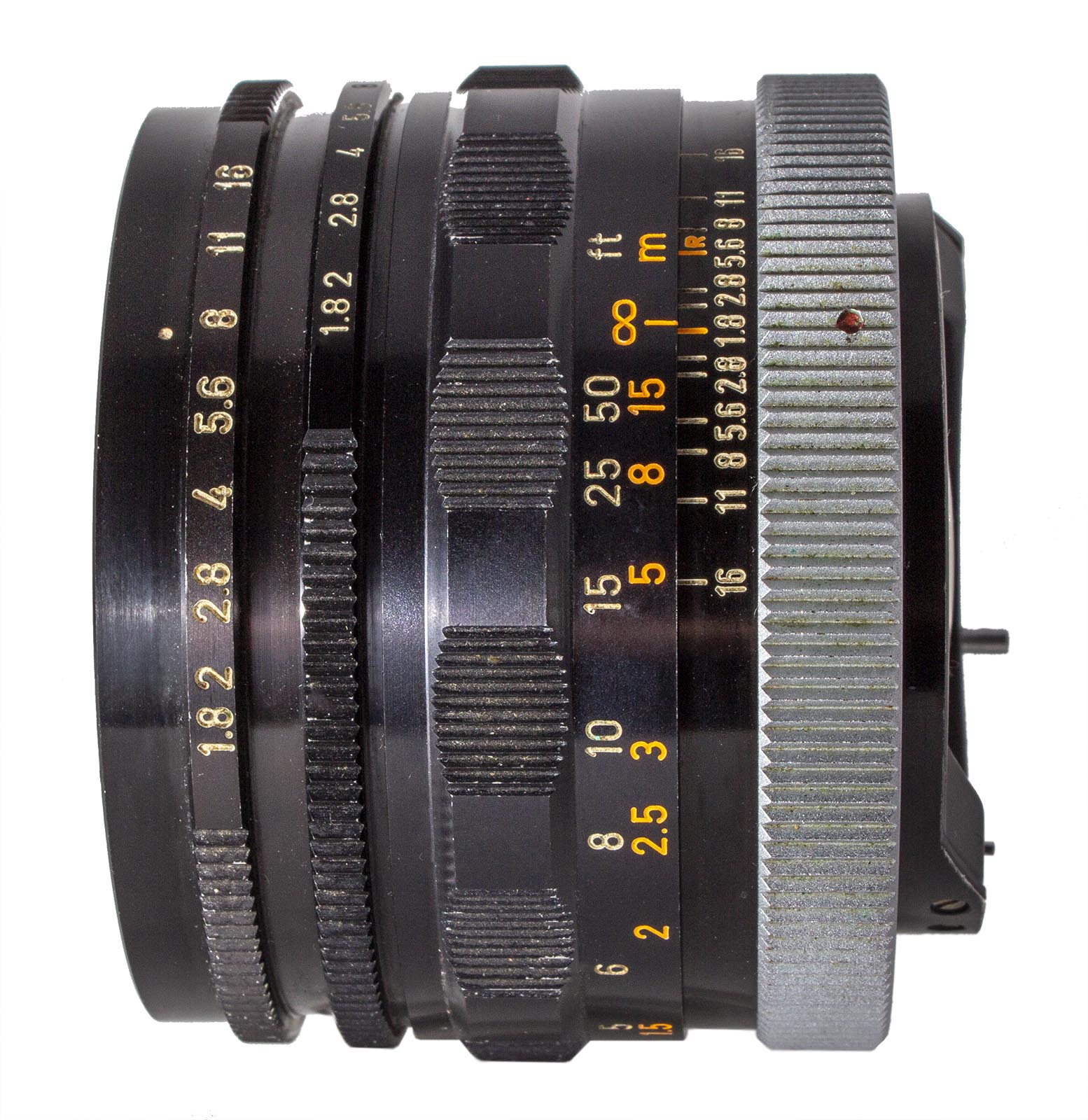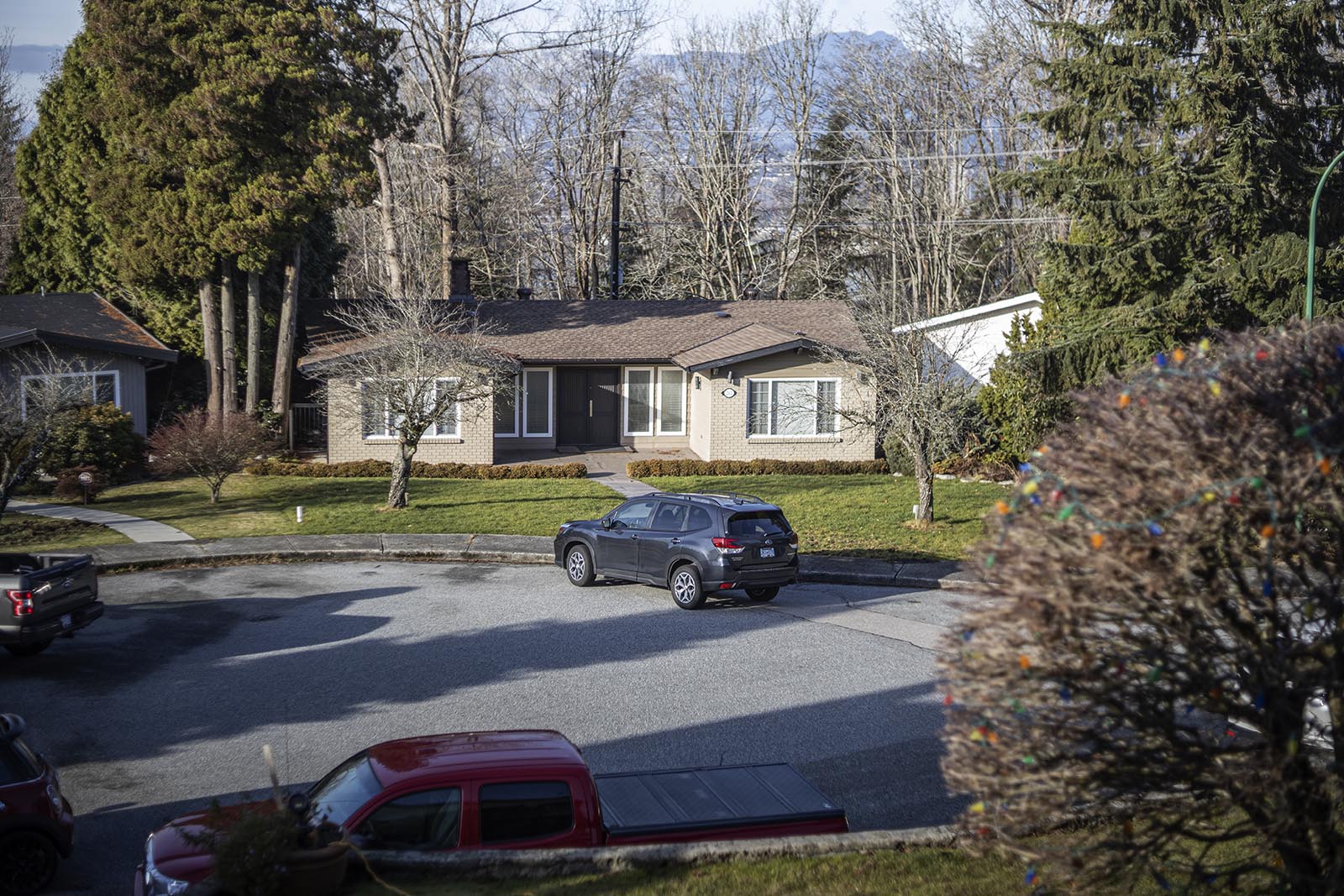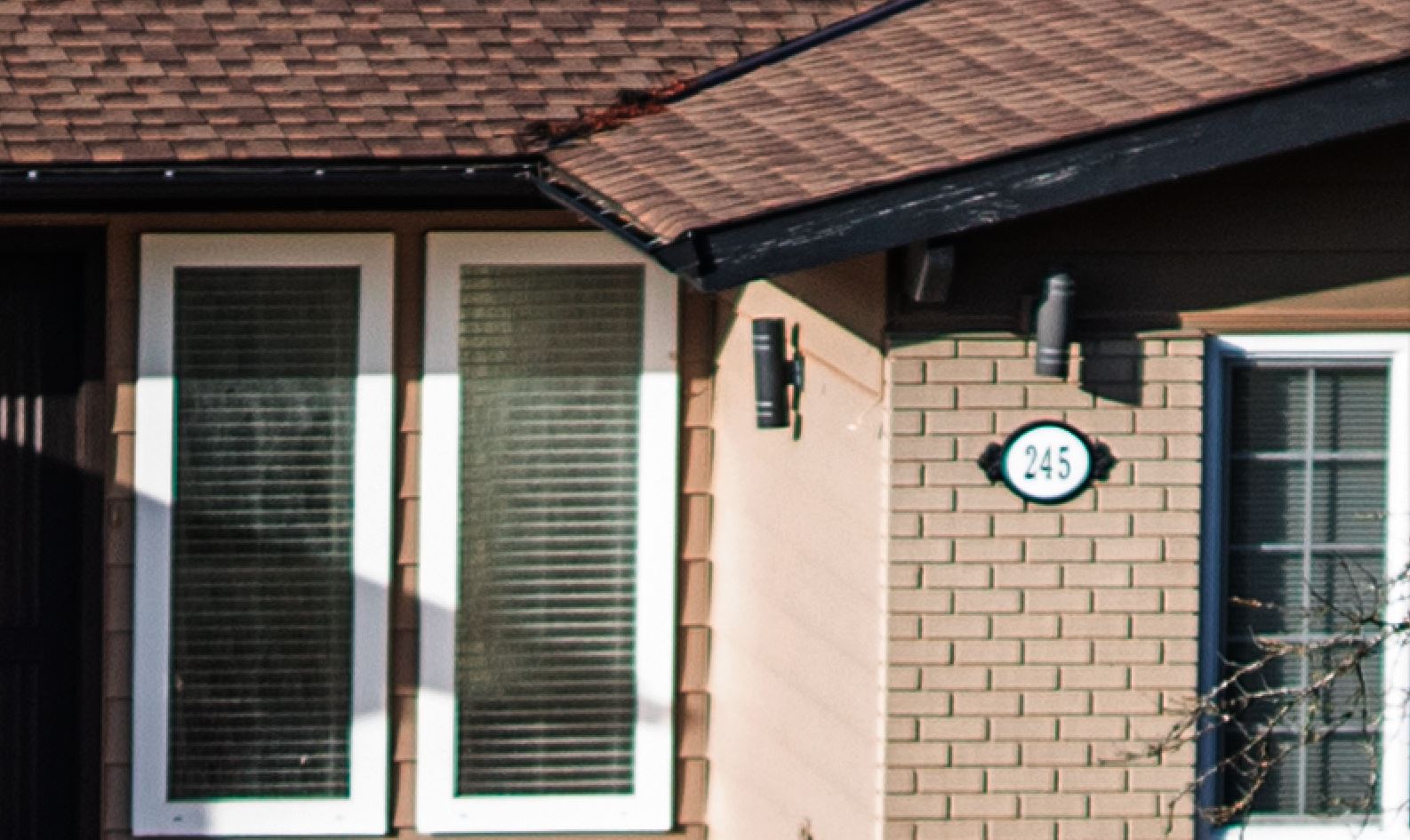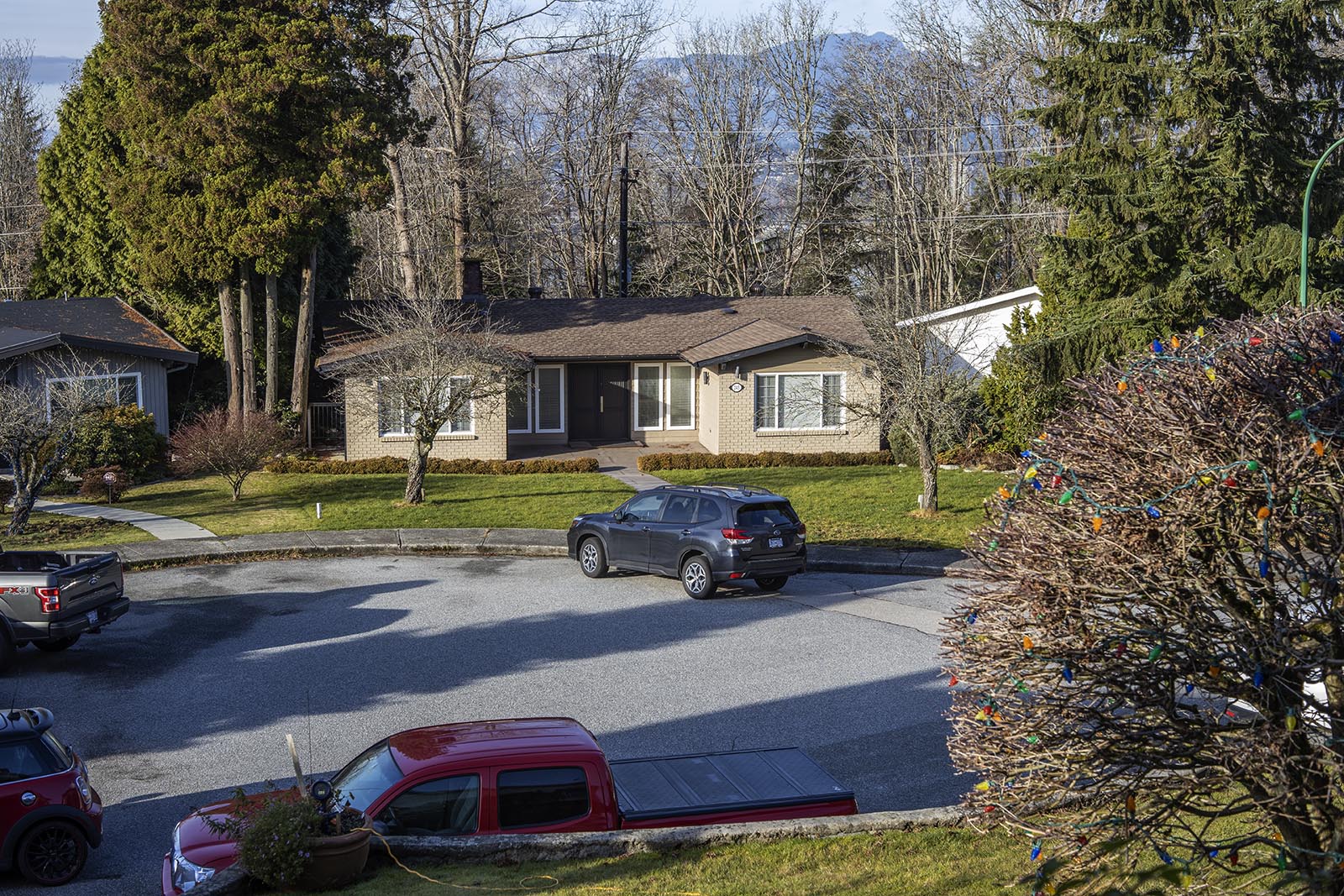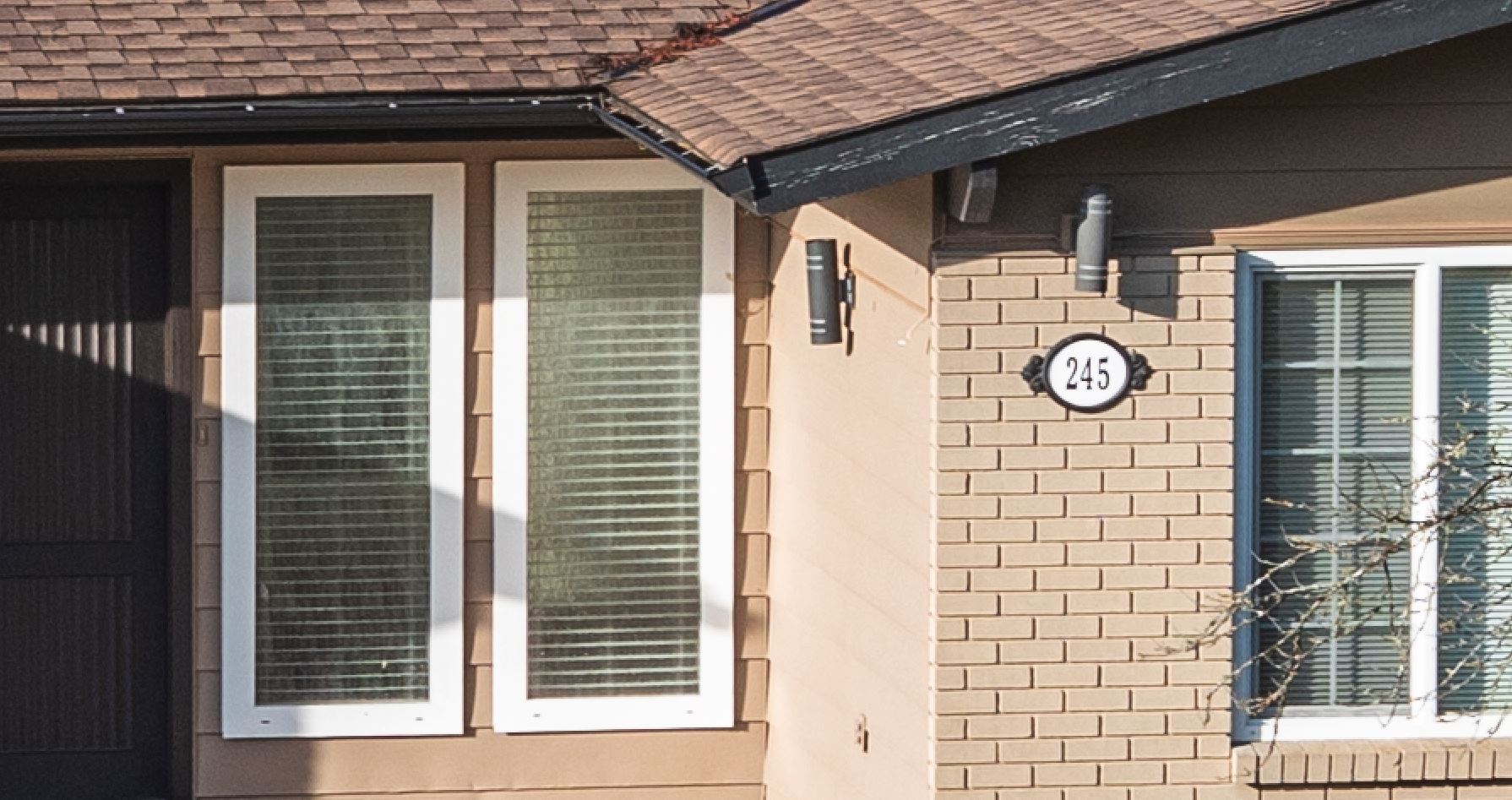The Canonflex
The Canon Canonflex, whatever
else we say about it below, is
a beautiful camera. It is solid,
well finished and beautifully
appointed. There are no less
than thirteen panels on the
body with separate pieces
of black leatherette all
applied by hand. The black
body and prism housing with
chrome top and bottem decks
provided a clean modern
appearance. It was a beautiful
camera, but it was the wrong camera at the wrong time.
The Canonflex was introduced in May of 1959. At the time, Canon was a manufacturer of rangefinder cameras. Their current model was the very successful Canon P (produced from 1958 till 1961) and the excellent Model 7 still lay in the future. However, the single lens reflex camera was available in the market.
Reflex cameras were nothing new having been around for many years in larger formats. There were a coule of problems with carrying the concept over to the 35mm format. One was that of focusing on such a small ground glass image. It was just too small to see clearly. This was before the pentaprism and images on the ground glass were reversed left to right. And of course, early reflex cameras did not have automatic mirrors so focusing had to be done and then the lens had to be stopped down. Fine for large format cameras on tripods but awkward in a hand held camera.
However, in 1936 the Kine model of the Exacta camea was introduced in Germany using 35mm film, a reflex mirror and ground glass focusing. In 1949 Contax came out with a true pentaprism SLR using 35mm film. In 1954 Asahi introduced their Asahiflex which had an instant return mirror. This was the first true Japanese SLR to go into production.
By 1959 there were several 35mm SLR’s available from Japanese manufacturers including offerings from Miranda, Minolta, and Topcon. As with mirrorless systems in our own time, the pressure was on for Canon to come up with a viable SLR camera.
The Canonflex came with the new “R” lens mount which has a locking collar on the lens that engages with a lock ring on the front of the body.
The back of the body is clean and neat. If it were not for the pentaprism bulge in the center top it looks for all the world like a Canon Model 7 back.
Because of the moving mirror in the light path the thickness of the body in the center has been increased.
The Canonflex was announced in March of 1959. It was a purely mechanical camera with no built in light meter, although two brackets on the right front allow for a detachable light meter to be mounted.
The large shutter speed dial offered speeds from 1 second to 1/1000th of a second. A film speed reminder is located around the rewind crank and the tab for setting the speed is located under the crank. The serrated device to the left of the shutter speed dial is a shutter lock which is engaged by moving the lever to the left.
The round device on the right front is the self timer. The tab is flipped out and rotated to arm the timer. Very modern looking for its day.
The flash attachment is on the left end and is the same as that used on the later rangefinder cameras.
On the Canonflex Canon went back to an older film advance found on earlier rangefinder cameras such as the Model VT: the trigger on the base plate. Film was advanced by using the fingers of the left hand. This was possible without taking the camera from the eye. In theory it allowed for very rapid shooting. However, in practice, this film advance was not generally popular.
The trigger advance system was awkward for left handed shooters but more annoying were the problems encountered when trying to use the camera on a tripod. The tripod usually interfered with the trigger operation.
This was a rugged camera and at the same time a very beautiful one. However, several factors worked against its success.
The original Canonflex was in production for only five months before it was replaced by the Canonflex R2000. Only about 17,000 were made. This was very disappointing for such a beautiful camera.
The ends of the Canonflex show its roots in the Canon rangefinder line. On the left end (at right above) is the flash attachment used on the Model VT, Model P and other rangefinder models.
The film advance trigger sits in a recess in the bottom plate and has a tab that folds down when the camera is in use for the fingers to grip.
The prism on the top of the camera slides to the rear and can be completely removed so that other viewfinders may be attached.
When the pentaprism is removed it reveals the focus screen stting above the mirror box. The camera should not be used like this as stray light may be admitted fogging the film.
In developing the Canonflex Canon seems to have taken the design of their then current rangefinder cameras and inserted a mirror box in the middle. This addition is thicker than the rangefinder camera bodies to accommodate the mirror which had to pivot up out of the light path when the picture was taken. But other than that, the similarity is unmistakable.
For instance, compare the body of the Canon Model 7, which came out a few months after the Canonflex, with the Canonflex body. The similarities are striking!
The bodies from the top are very similar except for the pentaprism housing mounted over the mirror box of the Canonflex.
Removing the pentaprism reveals how similar the bodies are in shape and size. The extra thickness of the mirrorbox can easily be seen.
In the Collection I have:
Collection No.: C-328
Serial No.: 11789
Condition: Shows some signs of wear but, overall, excellent. All functions appears to work normally. These photos are of my camera.
So, What Went Wrong?
The Canonflex was a great camera. It still is. Beautiful, sturdy, pleasant to look at and to use. So what happened that it only sold about 17,000 copies worldwide?
It is often said that the film advance trigger was a non-starter with the public. Maybe so, but, that can’t be the whole story. The Canonet originally had such a film advance and it was very popular.
I think that it was competition from another camera that was the problem. At almost at the same moment the Canonflex was announced Nikon announced its first single lens reflex camera: the Nikon Model F. It was not the Canonflex but the Nikon F that shook the camera world. But beyond Canon many companies felt the sting. This marked the beginning of the trend away from Leica as the “goto” professional camera and finally established Japanese cameras as the industry standard.
Think about the numbers: the Canonflex was in production for five months resulting in 17,000 units. The Nikon F was manufactured from 1959 thru 1974 and 862,000 were produced. Canon was simply blindsided by a superior camera and it took Canon until the Canon F-1 in 1971 to recover its footing.
The Canonflex lacked a mirror lockup feature, it did not have interchangeable focusing screens, it did not have a thumb winder, it was introduced with a poor lens lineup and initially there were no wide angle lenses. For a professional photographer these are shortcomings that will influence buying decisions.
Looking at what the Nikon F had that the Canonflex did not: it had provision for electric motor drives, it accepted a 250 exposure film back, changeable focus screens, 100% viewfinder, depth of field preview button, mirror lockup and a lens lineup that went from 21mm to 1000mm from the start. If you earned your living with your camera, there was no choice: you went with Nikon.
Let’s talk about the Lenses
Rangefinder camera lenses communicate one thing only to the camera body: the range at which they are focused. In a single lens reflex they don’t have to do that. However, if you want to have an automatic diaphram then the body has to communicate the shutter press to the lens. A single piece of information in both cases but in opposite directions.
The next problem is flange distance: the distance from the film plane to the surface of the lens mount. This is necessarily larger because the mirror has to have room to swing up. This puts new demands on the lens design.
Canon came to the conclusion that a new lens mount design was required. The result was the “R” lens mount first seen on the Canonflex. The back of the lens had a rotating locking ring which matted with lugs on the camera to hold the lens secure. This system is almost identical with the FL and FD mounting systems. However they are not totally interchangeable. The pins on the back of the “R” lenses are not the same as those on the FL and FD lenses and some of these lenses can damage the Canonflex. It is best to treat them as being incompatible and not try to mate them.
Canon R 50mm f/1.8
The Canonflex shipped with the R 50mm f/1.8 lens. This is a much bigger lens than the rangefinder “S” lenses that preceded it. I assume the reason for this is a combination of the larger lens mount and the added complexity of the automatic diaphragm internally.
The first thing you will notice is the two f/stop rings. The ring to the front sets the f/stop that will be automatically set when the shutter is fired. The one to the rear is used when you want to use the lens manually or to check depth of field. The User Manual says that if you are intending to use the manual ring the preset ring should be set to 1.8 to avoid strain on internal mechanisms.
There were actually three variations of this lens starting the R 50mm f/1.8 (I) introduced in May of 1959 with the original Canonflex camera. The Canon Museum describes it here.
The second version, R 50mm f/1.8 (II), was introduced in August of 1960 and is described here. The third version, R 50mm f/1.8 (III) was introduced in April of 1963 and is described here.
I am a little confused about the differences between them but that’s not important here. I’ll deal with that in the Lenses section. All three look almost identical and operate the same way. Version (I) weighs 295 grams while the other two weigh in at 305 grams. Beyond that it gets confusing. I have been doing some research looking at lenses on the internet and in particular lenses for sale but I have yet to clearly understand how to tell them apart.
The one shown here is an example of the first model from my Collection. It is the appropriate lens to go with the original Canonflex.
This example functions fine and appears clear and scratch free. But how good is it? I had to find out. As usual, my go to test is to mount the lens on my Canon R via an adapter. Once done I took it out to try it.
I apologize for the simple pictures but we were not out to make “art”. All I was after was a few example pictures. As you can see, this is a wonderful lens and very much up to the Canon standard for fine optics.
In preparing to write this I have been spending time with my Canonflex and I am now anxious to take it out and shoot it. I have film in one of my AE-1’s at the moment that I want to finish and then the Canonflex is “on deck”. It is a funny thing, but I really enjoy shooting these old cameras.
The three images above are shot at f/1.8. The one on the left is the full frame, the one in the center is the center of the image at 200% and the right image is from the upper left corner, again, at 200%. As might be expected, the image is sharp in the center but a little soft on the sharp edges. The corner is much softer but not unpleasant. What I notice is the relative absence of color fringing which I would have expected to find.
These images are the same as the three obove them except they are shot at f/8.0. The softness is gone and the corner image is very much improved. Again, color fringing is beautifully controlled. This is a good lens and, given that it was designed as a film lens, it was excellent for it’s day and it’s intended camera.
This website is the work of R. Flynn Marr who is solely responsible for its contents which are subject to his claim of copyright. User Manuals, Brochures and Advertising Materials of Canon and other manufacturers available on this site are subject to the copyright claims and are the property of Canon and other manufacturers and they are offered here for personal use only.

